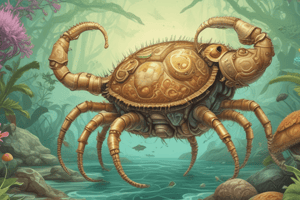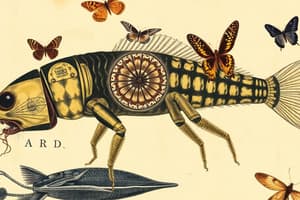Podcast
Questions and Answers
What complication arises in classifying invertebrates due to the lifestyle of some species?
What complication arises in classifying invertebrates due to the lifestyle of some species?
- Morphological similarities across groups
- Parasitism complicating classification (correct)
- Limited access to genetic data
- Absence of developmental stages
Why is understanding invertebrate classification important for ecological studies?
Why is understanding invertebrate classification important for ecological studies?
- It provides insights into vertebrate evolution
- It eliminates the need for genetic research
- It is crucial for comprehending ecosystem dynamics (correct)
- It helps in assessing the impact of climate change
Which factor does NOT contribute to the challenges in invertebrate classification?
Which factor does NOT contribute to the challenges in invertebrate classification?
- Incomplete fossil records
- The diversity of developmental stages (correct)
- Microscopic characteristics of tiny invertebrates
- Morphological variations among groups
What role does genetic evidence play in understanding evolutionary relationships?
What role does genetic evidence play in understanding evolutionary relationships?
How does invertebrate classification impact conservation efforts?
How does invertebrate classification impact conservation efforts?
Which characteristic is used to differentiate between organisms in the classification of invertebrates?
Which characteristic is used to differentiate between organisms in the classification of invertebrates?
What is a major distinguishing feature of Phylum Arthropoda?
What is a major distinguishing feature of Phylum Arthropoda?
Which phylum is known for having a water vascular system?
Which phylum is known for having a water vascular system?
Which of the following is a characteristic of Mollusca?
Which of the following is a characteristic of Mollusca?
What sets Platyhelminthes apart from other invertebrate phyla?
What sets Platyhelminthes apart from other invertebrate phyla?
Which invertebrate group is recognized for being primarily parasitic?
Which invertebrate group is recognized for being primarily parasitic?
Which characteristic describes the anatomical arrangement of Cnidarians?
Which characteristic describes the anatomical arrangement of Cnidarians?
Which of the following classifications does NOT belong to the invertebrates?
Which of the following classifications does NOT belong to the invertebrates?
Flashcards
Invertebrate Characteristics
Invertebrate Characteristics
Animals without a backbone or spinal column.
Invertebrate Classification
Invertebrate Classification
Complex and constantly evolving system based on shared traits like body plans, development, and genetics.
Radial Symmetry
Radial Symmetry
Body parts arranged in a circle around a central axis.
Bilateral Symmetry
Bilateral Symmetry
Signup and view all the flashcards
Coelom (Body Cavity)
Coelom (Body Cavity)
Signup and view all the flashcards
Segmentation
Segmentation
Signup and view all the flashcards
Exoskeleton
Exoskeleton
Signup and view all the flashcards
Arthropoda Phylum
Arthropoda Phylum
Signup and view all the flashcards
Developmental Stages
Developmental Stages
Signup and view all the flashcards
Genetic Evidence
Genetic Evidence
Signup and view all the flashcards
Evolutionary Relationships
Evolutionary Relationships
Signup and view all the flashcards
Invertebrate Classification Challenges
Invertebrate Classification Challenges
Signup and view all the flashcards
Importance of Invertebrate Classification
Importance of Invertebrate Classification
Signup and view all the flashcards
Study Notes
- Invertebrates are animals without a backbone or spinal column.
- This vast group encompasses a huge diversity of organisms, differing significantly in their morphology, physiology, and evolutionary history.
- Classification of invertebrates is complex and constantly evolving due to new discoveries and insights.
- Various systems are used to classify invertebrates, often based on shared characteristics like body plans, developmental stages, and genetic information.
Major Invertebrate Phyla
- Porifera (Sponges): Simple, multicellular animals characterized by porous bodies and lack of true tissues or organs.
- Cnidaria (Jellyfish, Corals, Anemones): Radially symmetrical animals with stinging cells (cnidocytes) for capturing prey. Exhibit a basic nerve net and are mostly aquatic.
- Platyhelminthes (Flatworms): Bilaterally symmetrical, unsegmented worms with a simple body plan. Many are parasitic.
- Nematoda (Roundworms): Bilaterally symmetrical, unsegmented worms with a complete digestive system. Found in diverse environments, some are parasitic.
- Annelida (Segmented Worms): Bilaterally symmetrical, segmented worms with a coelom. Examples include earthworms and leeches.
- Mollusca (Snails, Clams, Octopuses): Soft-bodied animals often with a hard shell. A diverse group with a wide range of adaptations, including a mantle and often a muscular foot.
- Arthropoda (Insects, Crustaceans, Spiders): Characterized by segmented bodies, jointed appendages, and an exoskeleton. The largest animal phylum.
- Echinodermata (Sea Stars, Sea Urchins): Radially symmetrical marine animals with a unique water vascular system. This system is crucial for locomotion, feeding, and respiration.
Key Characteristics Used in Classification
- Body Symmetry: Radial symmetry (arranged in a circle around a central axis) or bilateral symmetry (mirror-image halves).
- Body Cavity: Presence or absence of a coelom (body cavity).
- Segmentation: Presence or absence of repeating body units (segments).
- Presence of Appendages: Jointed limbs used for locomotion, feeding, or other functions.
- Exoskeletons: Hard outer coverings that provide support and protection.
- Feeding Mechanisms: How animals obtain nutrients, whether filter-feeding, predatory, or parasitic.
- Nervous System: The presence and complexity of nerve cells and sensory structures.
- Circulatory System: How organisms transport oxygen and nutrients throughout their bodies.
- Developmental Stages: Distinct stages in the life cycle of an organism.
- Genetic Evidence: Analysis of DNA sequences revealing evolutionary relationships.
Challenges in Invertebrate Classification
- Evolutionary Relationships: Determining the precise relationships between different invertebrate groups can be challenging due to incomplete fossil records and convergent evolution.
- Morphological Variations: The wide range of morphological adaptations within invertebrate groups makes precise classification difficult.
- Parasitism: The parasitic lifestyle of some species complicates classification and understanding of evolutionary histories.
- Microscopic Organisms: Classifying tiny invertebrates (e.g., some protists) can be demanding due to microscopic characteristics not easily observable.
Importance of Invertebrate Classification
- Understanding Diversity: Classification allows us to understand the vast array of life forms and their interrelationships.
- Conservation Efforts: Identifying different invertebrate species is vital for effective conservation efforts.
- Ecological Studies: Understanding invertebrate communities is crucial for comprehending ecosystem dynamics.
- Medical Applications: Some invertebrates serve as models for studying diseases and developing treatments.
Studying That Suits You
Use AI to generate personalized quizzes and flashcards to suit your learning preferences.
Description
Explore the diverse world of invertebrates in this quiz. Learn about major phyla including Porifera, Cnidaria, and Platyhelminthes, along with their unique characteristics and classifications. Dive into the complexities of invertebrate biology and evolution.




